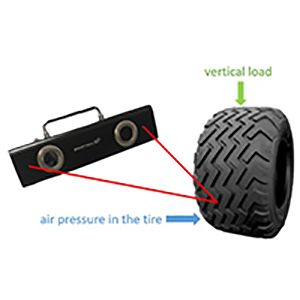Use of 3D scanning technique to determine tire deformation in static conditions

Published:31 March 2022
Abstract Views: 873
PDF: 463
HTML: 51
HTML: 51
Publisher's note
All claims expressed in this article are solely those of the authors and do not necessarily represent those of their affiliated organizations, or those of the publisher, the editors and the reviewers. Any product that may be evaluated in this article or claim that may be made by its manufacturer is not guaranteed or endorsed by the publisher.
All claims expressed in this article are solely those of the authors and do not necessarily represent those of their affiliated organizations, or those of the publisher, the editors and the reviewers. Any product that may be evaluated in this article or claim that may be made by its manufacturer is not guaranteed or endorsed by the publisher.
Similar Articles
- Hyun Seok Song, Kyung Seok Sim, Tae Won Park, Optimal tread design for agricultural lug tires determined through failure analysis , Journal of Agricultural Engineering: Vol. 49 No. 1 (2018)
- Wei Deng, Chunjiang Zhao, Liping Chen, Xiu Wang, Constant pressure control for variable-rate spray using closed-loop proportion integration differentiation regulation , Journal of Agricultural Engineering: Vol. 47 No. 3 (2016)
- Andrea De Montis, Amedeo Ganciu, Fabio Recanatesi, Antonio Ledda, Vittorio Serra, Mario Barra, Stefano De Montis, The scientific production of Italian agricultural engineers: a bibliometric network analysis concerning the scientific sector AGR/10 Rural buildings and agro-forestry territory , Journal of Agricultural Engineering: Vol. 48 No. s1 (2017): Special Issue
- Volodymyr Bulgakov, Simone Pascuzzi, Semjons Ivanovs, Volodymyr Kuvachov, Yulia Postol, Francesco Santoro, Viktor Melnyk, Study of the steering of a wide span vehicle controlled by a local positioning system , Journal of Agricultural Engineering: Vol. 52 No. 3 (2021)
- Qing Guo, Huihuang Xia, A review of the discrete element method/modelling in agricultural engineering , Journal of Agricultural Engineering: Vol. 54 No. 4 (2023)
- Luigi Cavazza, Adriano Guarnieri, Angelo Fabbri, Chiara Cevoli, Giovanni Molari, Theoretical and experimental study on mechanical characterisation of a water drop impact on a solid surface , Journal of Agricultural Engineering: Vol. 47 No. 1 (2016)
- Daniela Lovarelli, Jacopo Bacenetti, Marco Fiala, A new tool for life cycle inventories of agricultural machinery operations , Journal of Agricultural Engineering: Vol. 47 No. 1 (2016)
- Albert Min, Nam Nguyen, Liam Howatt, Marlowe Tavares, Jaho Seo, Aeroponic systems design: considerations and challenges , Journal of Agricultural Engineering: Vol. 54 No. 1 (2023)
- Melis Inalpulat, Monitoring and multi-scenario simulation of agricultural land changes using Landsat imageries and future land use simulation model on coastal of Alanya , Journal of Agricultural Engineering: Vol. 55 No. 1 (2024)
- Asiwan Kultongkham, Supakit Kumnon, Tawan Thintawornkul, Teeranoot Chanthasopeephan, The design of a force feedback soft gripper for tomato harvesting , Journal of Agricultural Engineering: Vol. 52 No. 1 (2021)
You may also start an advanced similarity search for this article.

 https://doi.org/10.4081/jae.2022.1221
https://doi.org/10.4081/jae.2022.1221 






